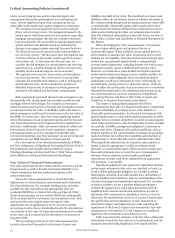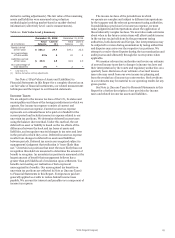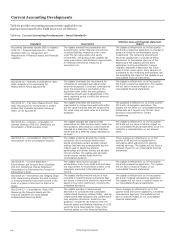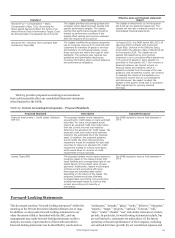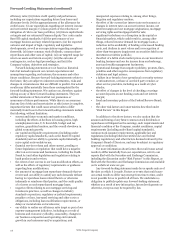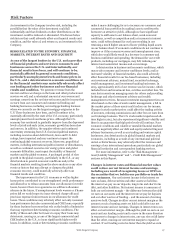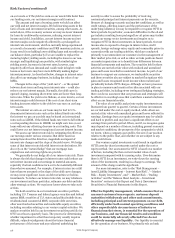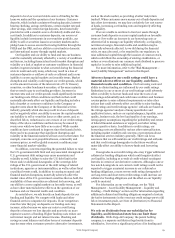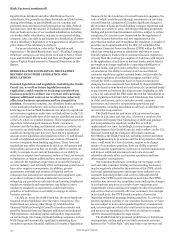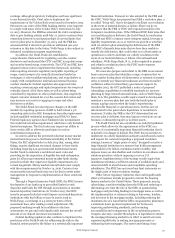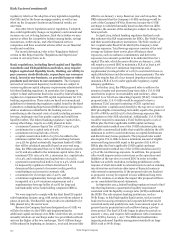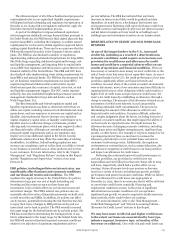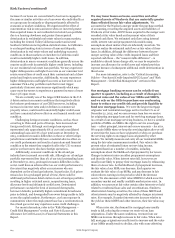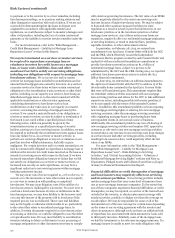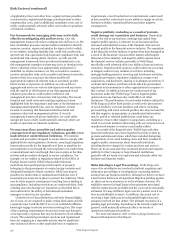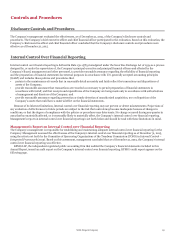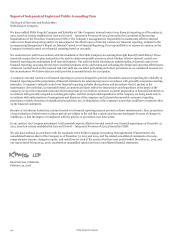Wells Fargo 2015 Annual Report Download - page 124
Download and view the complete annual report
Please find page 124 of the 2015 Wells Fargo annual report below. You can navigate through the pages in the report by either clicking on the pages listed below, or by using the keyword search tool below to find specific information within the annual report.Risk Factors (continued)
regulatory reform or the adoption of any legislation regarding
the GSEs and/or the home mortgage market, as well as any
effect on the Company’s business and financial results, are
uncertain.
Any other future legislation and/or regulation, if adopted,
also could significantly change our regulatory environment and
increase our cost of doing business, limit the activities we may
pursue or affect the competitive balance among banks, savings
associations, credit unions, and other financial services
companies, and have a material adverse effect on our financial
results and condition.
For more information, refer to the “Regulatory Reform”
section in this Report and the “Regulation and Supervision”
section in our 2015 Form 10-K.
Bank regulations, including Basel capital and liquidity
standards and FRB guidelines and rules, may require
higher capital and liquidity levels, limiting our ability to
pay common stock dividends, repurchase our common
stock, invest in our business, or provide loans or other
products and services to our customers. The Company
and each of our insured depository institutions are subject to
various regulatory capital adequacy requirements administered
by federal banking regulators. In particular, the Company is
subject to final and interim final rules issued by federal banking
regulators to implement Basel III capital requirements for U.S.
banking organizations. These rules are based on international
guidelines for determining regulatory capital issued by the Basel
Committee on Banking Supervision (BCBS) and are designed to
address weaknesses identified in the banking sector as
contributing to the financial crisis of 2008, including excessive
leverage, inadequate and low quality capital and insufficient
liquidity buffers. The federal banking regulators’ capital rules,
among other things, require on a fully phased-in basis:
• a minimum Common Equity Tier 1 (CET1) ratio of 4.5%;
• a minimum tier 1 capital ratio of 6.0%;
• a minimum total capital ratio of 8.0%;
• a capital conservation buffer of 2.5% to be added to the
minimum capital ratios, and a capital surcharge between
1.0-4.5% for global systemically important banks (G-SIBs)
that will be calculated annually (based on year-end 2014
data, the FRB estimated that our G-SIB surcharge would be
2.0%) and also added to the minimum capital ratios (for a
minimum CET1 ratio of 9.0%, a minimum tier 1 capital ratio
of 10.5%, and a minimum total capital ratio of 12.5%);
• a potential countercyclical buffer of up to 2.5%, which would
be imposed by regulators at their discretion if it is
determined that a period of excessive credit growth is
contributing to an increase in systemic risk;
• a minimum tier 1 leverage ratio of 4.0%; and
• a minimum supplementary leverage ratio (SLR) of 5.0%
(comprised of a 3.0% minimum requirement and a
supplementary leverage buffer of 2.0%) for large and
internationally active bank holding companies (BHCs).
We were required to comply with the final Basel III capital
rules beginning January 2014, with certain provisions subject to
phase-in periods. The Basel III capital rules are scheduled to be
fully phased in by the end of 2021.
Because the Company has been designated as a G-SIB, we
will also be subject to the FRB’s rule implementing the
additional capital surcharge on G-SIBs. Under the rule, we must
annually calculate our surcharge under two prescribed methods
and use the higher of the two surcharges. The G-SIB surcharge
will be phased in beginning on January 1, 2016 and become fully
effective on January 1, 2019. Based on year-end 2014 data, the
FRB estimated that the Company’s G-SIB surcharge would be
2.0% of the Company’s RWAs. However, because the G-SIB
surcharge is calculated annually based on data that can differ
over time, the amount of the surcharge is subject to change in
future periods.
In April 2014, federal banking regulators finalized a rule
that enhances the SLR requirements for BHCs, like Wells Fargo,
and their insured depository institutions. The SLR consists of
tier 1 capital under Basel III divided by the Company’s total
leverage exposure. Total leverage exposure consists of the total
average on-balance sheet assets, plus off-balance sheet
exposures, such as undrawn commitments and derivative
exposures, less amounts permitted to be deducted from tier 1
capital. The rule, which becomes effective on January 1, 2018,
will require a covered BHC to maintain a SLR of at least 5.0%
(comprised of the 3.0% minimum requirement and a
supplementary leverage buffer of 2.0%) to avoid restrictions on
capital distributions and discretionary bonus payments. The rule
will also require that all of our insured depository institutions
maintain a SLR of 6.0% under applicable regulatory capital
adequacy guidelines.
In October 2015, the FRB proposed rules to address the
amount of equity and unsecured long-term debt a U.S. G-SIB
must hold to improve its resolvability and resiliency, often
referred to as Total Loss Absorbing Capacity (TLAC). Under the
proposed rules, U.S. G-SIBs would be required to have a
minimum TLAC amount (consisting of CET1 capital and
additional tier 1 capital issued directly by the top-tier or covered
BHC plus eligible external long-term debt) equal to the greater of
(i) 18% of RWAs and (ii) 9.5% of total leverage exposure (the
denominator of the SLR calculation). Additionally, U.S. G-SIBs
would be required to maintain a TLAC buffer equal to 2.5% of
RWAs plus the firm’s applicable G-SIB capital surcharge
calculated under method one of the G-SIB calculation plus any
applicable countercyclical buffer that would be added to the 18%
minimum in order to avoid restrictions on capital distributions
and discretionary bonus payments. The proposed rules would
also require U.S. G-SIBs to have a minimum amount of eligible
unsecured long-term debt equal to the greater of (i) 6.0% of
RWAs plus the firm’s applicable G-SIB capital surcharge
calculated under method two of the G-SIB calculation and (ii)
4.5% of the total leverage exposure. In addition, the proposed
rules would impose certain restrictions on the operations and
liabilities of the top-tier or covered BHC in order to further
facilitate an orderly resolution, including prohibitions on the
issuance of short-term debt to external investors and on entering
into derivatives and certain other types of financial contracts
with external counterparties. If the proposed rules are finalized
as proposed, we may be required to issue additional long-term
debt. We continue to evaluate the impact this proposal will have
on our consolidated financial statements.
In September 2014, federal banking regulators issued a final
rule that implements a quantitative liquidity requirement
consistent with the liquidity coverage ratio (LCR) established by
the BCBS. The rule requires banking institutions, such as
Wells Fargo, to hold high-quality liquid assets, such as central
bank reserves and government and corporate debt that can be
converted easily and quickly into cash, in an amount equal to or
greater than its projected net cash outflows during a 30-day
stress period. The final LCR rule began its phase-in period on
January 1, 2015, and requires full compliance with a minimum
100% LCR by January 1, 2017. The FRB also finalized rules
imposing enhanced liquidity management standards on large
BHCs such as Wells Fargo.
Wells Fargo & Company
122


